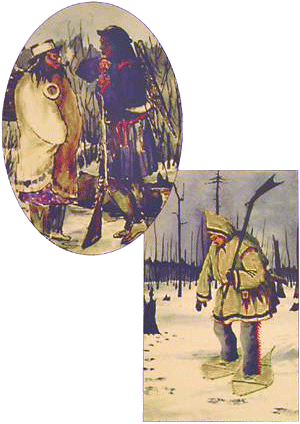Introduction
“In the winter when the snow will bear them, they fasten to their feet their snow shoes which are made like a large Racket we play at Tennis with, lacing them with Deers-guts and the like.”
John Josselyn, Two Voyages to New England (1673)

For Native Peoples of the sub Arctic, snowshoeing was not a winter recreational sport. The ability to make and use snowshoes was a life skill essential to survival. By distributing a person’s body weight over a broader surface, snowshoes allowed easy movement over snow.
Throughout the sub arctic, distinct snowshoe styles developed – bearpaw, beavertail, swallowtail and elbow shoe – in response to the need to travel over specific terrains and snow types. Long narrow forms with upturned toes were ideal for open country, while oval shoes with short tails or no tails permitted the wearer to maneuver in hilly, densely wooded or brush-filled terrain.
It was men’s work to make snowshoe frames from brown or white ash, or yellow or white birch. Frames were hewn and shaped with a crooked knife and bent around their maker’s knee or steamed around a frame or form. One or two cross bars were then mortised in and the tail of the shoe pinned together. Once the frame was constructed, women did the rawhide infilling work with babiche – lacing made from untanned caribou, moose or deer hide. Snowshoe makers “signed” their work with distinctive frame construction techniques and ornate, decorative babiche work.
The snowshoes featured in this exhibit include Penobscot, Passamaquoddy, and Maliseet examples as well as Cree, Ojibwe, Montaignais and Innu forms. Some date to the 1800s while others were made in 2000. Each is a gift from Gluskabe.
